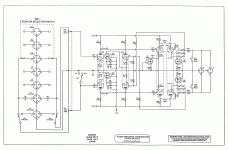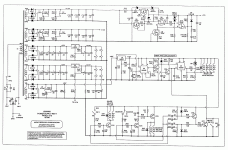Well i did turn LED incorectly and manage to produce magic smoke from R1.... and my caps are for tea-bag-plastic body.
Ok i bought multi-function tester TC1 and will test all components. Since i have 2 pcb.. I will pull all components out and measure all and start from schrach. Well resistors will be in. For now i pull out trimers and C (1 leg).
Mybe you know link where to buy original 2sk117gr?
Ok i bought multi-function tester TC1 and will test all components. Since i have 2 pcb.. I will pull all components out and measure all and start from schrach. Well resistors will be in. For now i pull out trimers and C (1 leg).
Mybe you know link where to buy original 2sk117gr?
Search in this German shop Batterien und Elektronikartikel günstig online kaufen
Good price in Poland, untill they last 
https://www.piekarz.pl/pl/?q=2sk117
Even if not stated, they are GR
https://www.piekarz.pl/pl/?q=2sk117
Even if not stated, they are GR
This sounds awfully familiar. I had the LED installed incorrectly too and my R1 practically exploded! Now I'm ordering new transistor kit from Tea-Bag...Well i did turn LED incorectly and manage to produce magic smoke from R1....
Interesting to see which components require to be replaced. At least Q1, Q2, D1 and D2 seem to be toasted.
How many SSHV2??
Hello!
We are working on a balanced circuit based on Audio research LS5 MKIII (see attachment). Will it be possible having 8 x SSHV2 per channel for this circuit?
This means each triode has its own SSHV2 reg.
In what area the SSHV2 outperform the stock regulator in the stock LS5 MKIII unit? Please advice.
Thanks!
Hello!
We are working on a balanced circuit based on Audio research LS5 MKIII (see attachment). Will it be possible having 8 x SSHV2 per channel for this circuit?
This means each triode has its own SSHV2 reg.
In what area the SSHV2 outperform the stock regulator in the stock LS5 MKIII unit? Please advice.
Thanks!
Attachments
Just IMHO.
Technically - yes, but in the balanced circuits the single point of power for a stage is essential for best PSRR, so I'd not divide the power supply into so many pieces. The first two tubes (4 triodes) form one stage, so - one SSHV, then - tube (double triode) is the second stage which I'd power from the same (first) SSHV. The only stage - output - deserves its own power supply and it can be anything really.Will it be possible having 8 x SSHV2 per channel for this circuit?
Difficult question, several answers here highlight the differences in the similar designs. But I wonder - why do you leave the -110V supply alone? It is the part of the B+s for the first stages!In what area the SSHV2 outperform the stock regulator in the stock LS5 MKIII unit?
As SSHV2 only capable positive supply, not negative. Can i use SSHV2 for area you have just mentioned and different regulator other than SSHV2 for the negative?
Just IMHO.Technically - yes, but in the balanced circuits the single point of power for a stage is essential for best PSRR, so I'd not divide the power supply into so many pieces. The first two tubes (4 triodes) form one stage, so - one SSHV, then - tube (double triode) is the second stage which I'd power from the same (first) SSHV. The only stage - output - deserves its own power supply and it can be anything really.
Difficult question, several answers here highlight the differences in the similar designs. But I wonder - why do you leave the -110V supply alone? It is the part of the B+s for the first stages!
As far as the transformer in the original power supply uses dedicated secondary for -110V you can put the SSHV2 here even if it has only minus common wire.As SSHV2 only capable positive supply, not negative. Can i use SSHV2 for area you have just mentioned and different regulator other than SSHV2 for the negative?
If you built your own power supply you also can use SSHV2, for this case as "folded" supply. It'll make the power supply a bit simpler.
In reality you can avoid the second SSHV2 in folded layout and still save the great quality of supply voltage.
Last edited:
Let me clarify what you told me so far. 2 x SSHV2 per channel is what you suggested.
One SSHV2 for first stage's 4 triodes and second stage's for 2 triodes. And the other SSHV2 for the final output stage.
OK, can I use a different regulator other than SSHV2 for the negative rail? And how many regulator for the negative should I use per channel?
Thanks!
One SSHV2 for first stage's 4 triodes and second stage's for 2 triodes. And the other SSHV2 for the final output stage.
OK, can I use a different regulator other than SSHV2 for the negative rail? And how many regulator for the negative should I use per channel?
Thanks!
As far as the transformer in the original power supply uses dedicated secondary for -110V you can put the SSHV2 here even if it has only minus common wire.
If you built your own power supply you also can use SSHV2, for this case as "folded" supply. It'll make the power supply a bit simpler.
In reality you can avoid the second SSHV2 in folded layout and still save the great quality of supply voltage.
I should have mentioned that all I was saying - IMHO, but it's never late to do that.Let me clarify what you told me so far. 2 x SSHV2 per channel is what you suggested.
One SSHV2 for first stage's 4 triodes and second stage's for 2 triodes. And the other SSHV2 for the final output stage.
The schematic we are speaking about uses all stages based on CCS. The fact almost lifts serious requirements to the power supply, because there is (almost) no current changes in the load due to signal amplification. While I can see a benefit in using the SSHV in the design (mainly in the stability and rectification pulse filtering region) I do not see a single benefit for multiplying them in one channel at all. Two SSHV2 for channel was suggested only as hypotetical logic for that thoughts.
In short: I'd use ONE SSHV per channel (or even one SSHV for two channel).
Using SSHV in the negative rail has discussed many times in the thread. You can look for example here:OK, can I use a different regulator other than SSHV2 for the negative rail? And how many regulator for the negative should I use per channel?
http://www.diyaudio.com/forums/powe...tic-mosfet-hv-shunt-regs-528.html#post4793893
If you ask me I'd use one SSHV for a channel. Unlike B+, the rail (-110V) is more important, because it is in the signal path directly.
All that I said above is for the copy of the original PS design.
In my opinion you can easily change it for the combined "B+" + "-110V" power supply and use only one regulator (SSHV for example) per channel with even cleaner signal path. It do need some countings, but a good friend with some knowledge in the field will do that easily.
that attenuator shown in the left diagram cannot be balanced impedance.Hello!
We are working on a balanced circuit based on Audio research LS5 MKIII (see attachment). Will it be possible having 8 x SSHV2 per channel for this circuit?
This means each triode has its own SSHV2 reg.
In what area the SSHV2 outperform the stock regulator in the stock LS5 MKIII unit? Please advice.
Thanks!
The attenuators are inherently not identical impedance. The tapping point/wiper is inherently not equal and this too affects the balance of impedance.
Balanced means balanced impedance and that applies to the connection between modules. It's the connection that is balanced impedance. it's the precision of this balance that attains the interference rejection.
I fix my 1 bord..1 to go. Input V was 270 to 236V.. output was 200V @20mA (reg 45mA)...driftet 6V in 15min...first 3 V was like in 4min.... So regulator is working ok..
I testet all components .. kontakts..pcb connection (could be brocken)..all ok...
Than i checket dummy load...It was 0 ..BLODY DUMMY LOAD...
After i soldered on first dummy load 10W 5k must brocken some internal wire or something. That was the bitchiest one I ever had!!
I testet all components .. kontakts..pcb connection (could be brocken)..all ok...
Than i checket dummy load...It was 0 ..BLODY DUMMY LOAD...
After i soldered on first dummy load 10W 5k must brocken some internal wire or something. That was the bitchiest one I ever had!!
Salas SSHV2 for Curcio Daniel II??
Hello!
I'm seeking opinion for the mod to my other very old preamp, and which is a Curcio Audio Daniel II. If Salas SSHV2 is in used, whether the attached circuit diagram is a correctly removed the stock series regulator circuitry.
This is a diagram my friend sent me last year and now I have time look into that.
Thanks in advance!
Hello!
I'm seeking opinion for the mod to my other very old preamp, and which is a Curcio Audio Daniel II. If Salas SSHV2 is in used, whether the attached circuit diagram is a correctly removed the stock series regulator circuitry.
This is a diagram my friend sent me last year and now I have time look into that.
Thanks in advance!
Attachments
Hello!
I'm seeking opinion for the mod to my other very old preamp, and which is a Curcio Audio Daniel II. If Salas SSHV2 is in used, whether the attached circuit diagram is a correctly removed the stock series regulator circuitry.
This is a diagram my friend sent me last year and now I have time look into that.
Thanks in advance!
The third to the right looks like a local rail filter. Maybe replace only the master.
It's normal if I connect the SSHV2 without load Q1 gone? VDCin 362V.
Better use a sturdy Schottky diode instead of the Zener (the one near the JFET) that it proved helpful in preventing accidents
- Home
- Amplifiers
- Power Supplies
- Simplistic MosFET HV Shunt Regs


